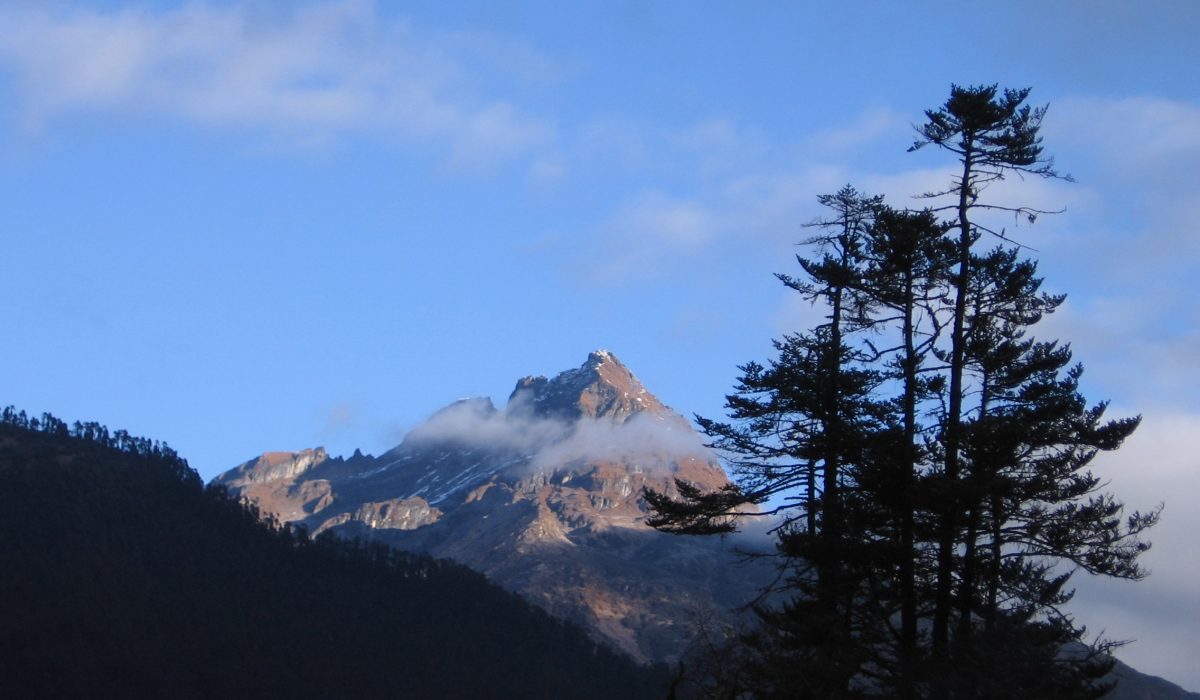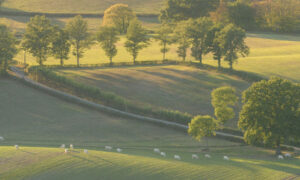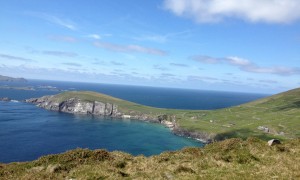
by Kate Dernocoeur, guest blogger
The Kingdom of Bhutan in the eastern Himalaya is among the world’s few remaining mystical, magical places. Hidden from external influences until just a few years ago, the tiny landlocked nation of mostly Buddhists continues to honor its traditional ways while also trying to enter the mainstream of the 21st century, cell phones, internet, and all.
My visit was focused on the rigorous “Chomolhari Trek.” The itinerary: hike 100 miles up and down some 55,000 vertical feet (including side trip days). With a latitude equal to Miami, the November weather was relatively kind, but it was definitely an alpine experience.

The basic geography of Bhutan, which lies east of Nepal bracketed by the superpowers of India and China, finds a wall of high mountains along the north border, then a series of about 26 isolated valleys, as if raked north to south by tiger claws. In medieval times, it was “a land of warlords, feuds, giant fortress/castles (“dzongs”), with intrigue, treachery, fierce battles and extraordinary pageantry.” [source: www.lonelyplanet.com]
We started in Paro (7,200′) drove nine miles north to the end of the road (8,500′), then walked for three days (and 35 miles) up the Paro River valley to Jangothang (13,382), the 11th century palace (now in ruins) that was once the home of the king of this valley.

We camped for two nights under the benign gaze of Chomolhari (24,035′), which is the home of the goddess Chomol, the protectress of Bhutan. There, we learned this: in the 1970s, when the nation first opened its doors to westerners, the mountain climbing community soon arrived. Soon, local farmers noticed that their crops were failing. After a couple of bad growing seasons, they went to the king. It seemed, they said, that perhaps the goddess Chomol was unhappy. Should people climb these sacred mountains? The king listened, and put an immediate stop to the mountain climbing. I find that sort of responsive leadership refreshing.
On our “rest” day we hiked five miles up to a hanging lake at 14,350′ where we had a stunning view of Chomolhari and her attendant mountains, including Jichu Drake (22,800′) and Tsering Kang (22,300′).


Ahead of us was another 65 miles of walking, including two high passes: Nyile La (15,980) and Yeli La (16,170′). At the time, those were high altitude records for me.
Bhutan is the nation which measures a concept known as “Gross National Happiness.” In the 1970s, King Jigme Singye Wangchuck realized that mere economic success did not necessarily translate into a content and happy society. “GNH is not a simple appraisal of the smiles on the faces of the populace; rather it encompasses explicit criteria to measure development projects and progress in terms of society’s greater good. A more sustainable happiness for the individual is believed to derive from such an approach.” [source www.lonelyplanet.com]
In 2011, 68 countries join the Kingdom of Bhutan to co-sponsor a resolution titled “Happiness: Towards a holistic approach to development.” It was adopted by consensus by the 193-member UN General Assembly. The vision is of a new economic paradigm based on well-being and sustainability that effectively integrates economic, social, and environmental objectives.

Now, by law, at least 60% of the country must remain forested for all future generations (it currently preserves more than 70%). In 2010, Bhutan became the first nation in the world to ban smoking (!), and in 2013, a goal of 100% organic farming was announced.
Certainly, much has changed in Bhutan since my 2005 visit. It has been “discovered” by enough people to build 5-star hotels, and you see fewer people dressed in traditional garb. Everyone seems to have a cell phone. But Bhutan is still a stunningly beautiful place. As I wrote in my journal, “It was hard to step on the plane…How can two weeks go past so very, very quickly? Time has a new dimension when you are living in magic.”

Additional Comment by Susan
I really enjoyed this post by Kate. She truly captures the spirit of Bhutan. What an amazing trip she took with my friend Margaret. Since I spent two weeks in Bhutan on a different kind of trip I have added on to this post with some images I hope will complement the picture Kate paints.
I, too, found Bhutan to be magical. It’s really not like any other place I’ve been. Peaceful. Beautiful. Serene. I was on a trip with 11 other travelers and our guide, bus drivers and local guides. We started and ended in Paro. Over the two weeks we visited small villages, Dzongs, gorgeous valleys, the home of our guide and finished with being able to attend a religious festival.
Here are some of my images that I hope will add to Kate’s images, capturing the feeling of this magical place.

Below is a typical Dzong. Dzongs are iconic buildings in Bhutan that house government offices and a Buddhist temple. Typically the monks live there. The gold roof is an indication of the temple part of the structure. Historically if the area was being invaded, the local people would gather inside the building. Now the interior courtyards are gathering spots and venues for the colorful festivals.


When we got away from Paro and Thimphu we saw people mostly wearing their native attire. Here are some examples



As Kate mentions, Bhutan is mostly Buddhist. Prayer wheels like this one are part of the religion and very visible in most villages and near the temples.

I am particularly enthralled with the beautiful ornamental painting I saw on public and residential buildings. Here’s a great example.


I will end with my favorite image of Bhutan. I took this photo outside the big festival. I think it expresses Bhutan in a state of transition that Kate talks about. The fellow in the front with his slicked back hair and cell phone contrasts with the monk with a passive gaze. The fellow in the front was checking out some lovely young women when I snapped this shot.
If you’d like read more about Bhutan and see pictures, both Kate and I have done blog posts. Simply go to the bottom of this post for the computer generated options or to the right hand column and type Bhutan into the search box. The different blog posts about this magical place will appear.

Thank you to Kate for sharing her experience.

Kate said I could say whatever I wanted in her bio for this blog post. My description of her includes writer, volunteer fire fighter, hiker, friend, blogger, writer, adventurer, Mother, lover of animals, horse back rider and really terrific person. How she finds time to do all she does I don’t know. I do know its great fun to have her in my life and on DesignDestinations.org.
Kate’s blog is called Generally Write.






Comments
5 CommentsBarb Rohwer
Mar 26, 2018Susan and Kate,
Thanks for your wonderful journal of both words and photos of Bhutan. What a fabulous opportunity for you both ( and Margaret ). I do live vicariously through many of your adventurous holidays!
Susan J. Smith
Mar 26, 2018Thanks, Barb, I appreciate your commenting on this blog post.
Margaret Idema
Mar 26, 2018Of all the adventures Kate and I have taken together, Bhutan tops them all…for the beauty of the country, for the comraderie with our fellow travelers, for the culture we experienced and for the feelings of accomplishment I had following our two weeks there. I love basking in the memories 13 years later.
Susan J. Smith
Mar 26, 2018Thanks for adding to this blog post, Margaret. Sounds like you and Kate had a most memorable experience.
Richard Edelen
Mar 27, 2018Thank you Susan, I really enjoyed reading that.